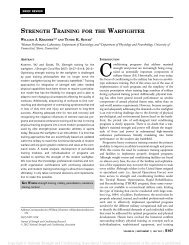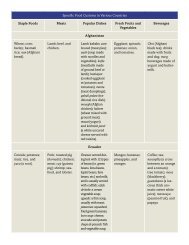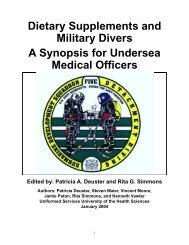Food Sources of Antioxidants Antioxidants Other Names Information ...
Food Sources of Antioxidants Antioxidants Other Names Information ...
Food Sources of Antioxidants Antioxidants Other Names Information ...
You also want an ePaper? Increase the reach of your titles
YUMPU automatically turns print PDFs into web optimized ePapers that Google loves.
<strong>Food</strong> <strong>Sources</strong> <strong>of</strong> <strong>Antioxidants</strong><br />
<strong>Antioxidants</strong> <strong>Other</strong> <strong>Names</strong> <strong>Information</strong> <strong>Sources</strong><br />
Vitamin C Ascorbic acid Water-soluble vitamin found in all body fluids; May be<br />
one <strong>of</strong> our first lines <strong>of</strong> defense. Cannot be stored by<br />
the body, so mustt eat fruits and vegetables.<br />
Citrus fruits, green peppers, broccoli,<br />
green leafy vegetables, strawberries, raw<br />
cabbage, and potatoes.<br />
Vitamin E<br />
Tocopherols, tocotrienols<br />
A fat-soluble vitamin stored in fat and liver; A powerful<br />
antioxidant.<br />
Wheat germ, nuts, seeds, whole grains,<br />
green leafy vegetables, vegetable oil and<br />
fish-liver oil.<br />
Beta-carotene Lycopene, carotenes The most studied <strong>of</strong> more than 600 different carotenoids<br />
that have been discovered, beta-carotene protects<br />
dark green, yellow and orange vegetables and<br />
fruits from solar radiation damage. It is thought that it<br />
plays a similar role in the body.<br />
Selenium None Interacts with many nutrients that affect the antioxidant<br />
balance <strong>of</strong> the cell. Thought to help fight cell<br />
damage and help protect against cancer. Best to get<br />
selenium through foods, as large doses <strong>of</strong> the supplement<br />
form can be toxic.<br />
Carrots, squash, broccoli, sweet potatoes,<br />
tomatoes, kale, collards, cantaloupe,<br />
peaches and apricots.<br />
Fish, shellfish, red meat, grains, eggs,<br />
chicken and garlic; Vegetables are a good<br />
source only if grown in selenium-rich soils.<br />
Polyphenol<br />
antioxidents<br />
Resveratrol, flavonoids<br />
<strong>Antioxidants</strong> characterized by several phenol functional<br />
groups. Important in combating oxidative stress.<br />
Principal benefit derived from consumption <strong>of</strong> a wide<br />
array <strong>of</strong> sources.<br />
Legumes, fruits such as apples, blackberries,<br />
cantaloupe, cherries, cranberries,<br />
grapes, pears, plums, raspberries, and<br />
strawberries; and vegetables such as broccoli,<br />
cabbage, celery, onion and parsley.<br />
Red wine, chocolate, green tea, olive oil,<br />
bee pollen and many grains.<br />
Flavonoids None Promote antioxidant activity, cellular health, and normal<br />
tissue growth and renewal throughout the body.<br />
Work with vitamin C to reduce oxidative stress for<br />
the water based portion <strong>of</strong> the cell. May slow down<br />
some <strong>of</strong> effects <strong>of</strong> aging. The more than 4,000 unique<br />
flavonoids are most effective when several types are<br />
consumed together.<br />
Cranberries, kale, beets, berries, red and<br />
black grapes, oranges, lemons, grapefruits,<br />
green tea.
<strong>Food</strong> <strong>Sources</strong> <strong>of</strong> <strong>Antioxidants</strong><br />
<strong>Antioxidants</strong> <strong>Other</strong> <strong>Names</strong> <strong>Information</strong> <strong>Sources</strong><br />
Peroxidase None An enzyme occurring in most plants, milk, animal<br />
liver, and leukocytes. Catalyzes the oxidation <strong>of</strong> various<br />
substances.<br />
Glutathione None Protects cells from toxins, such as free radicals. Produced<br />
in the human body from three key amino acids<br />
- cysteine, glycine, and glutamic acid.<br />
Cysteine None An amino acid and important free radical antioxidant<br />
in cellular systems. May block oxidation <strong>of</strong> free radical<br />
types engaged in aging, carcinogenesis, diabetes<br />
mellitus, and development <strong>of</strong> heart disease. Cysteine is<br />
incorporated into glutathione, which works along with<br />
vitamin E to protect cells against free radical oxidant<br />
damage. A nonessential amino acid synthesized in the<br />
liver from methionine. Excessive intake can result in<br />
liver damage, kidney stone formation, or even some<br />
forms <strong>of</strong> schizophrenia.<br />
Horseradish root, soybean, mango fruit,<br />
and turnip.<br />
Asparagus, avocado, grapefruit, squash,<br />
potato, cantaloupe, peach, zucchini, spinach,<br />
broccoli, watermelon, and strawberries.<br />
Fish, meat, and foods that yield sulfur<br />
containing amino acids (e.g. eggs) are the<br />
preferred sources for maintaining and<br />
increasing glutathione levels. Supplemental<br />
glutathione is only available in one active<br />
form, GSH.<br />
Animal protein is known to be higher in<br />
sulfur-containing amino acids, such as<br />
cysteine than vegetable proteins. Of the<br />
vegetable proteins, beans are generally<br />
higher in sulfur amino acids than grains.<br />
Eating grains and beans is useful for providing<br />
adequate cysteine intake.






![Body Composition and Military [PDF] - Human Performance ...](https://img.yumpu.com/43269347/1/190x245/body-composition-and-military-pdf-human-performance-.jpg?quality=85)
![Tips for Grocery Shopping [PDF]](https://img.yumpu.com/37447379/1/190x245/tips-for-grocery-shopping-pdf.jpg?quality=85)


![Synthetic Drugs [PDF] - Human Performance Resource Center](https://img.yumpu.com/37447322/1/190x245/synthetic-drugs-pdf-human-performance-resource-center.jpg?quality=85)



